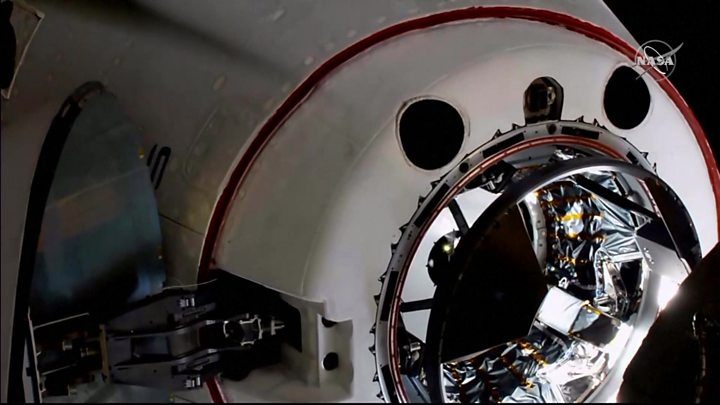
Media captionBehnken (L) and Hurley (R) in front row, join the ISS's existing crew
US astronauts Doug Hurley and Bob Behnken have docked with, and entered, the International Space Station (ISS).
Their Dragon capsule - supplied and operated by the private SpaceX company - attached to the bow section of the orbiting lab 422km above China.
After a wait for leak, pressure and temperature checks, the pair disembarked to join the Russian and American crew already on the ISS.
Hurley and Behnken launched from Florida on Saturday.
Theirs is the first crew outing launched from American soil since the retirement of the US space agency (Nasa) shuttles nine years ago.
The mission marks the beginning of a new era in which Nasa will be purchasing transport services from the commercial sector. No more will it own and operate the American vehicles that run to and from the station.
This will be done exclusively by firms such as SpaceX of Hawthorne, California, which is led by tech billionaire Elon Musk.
Confirmation of the Dragon's attachment at the ISS came at 14:16 GMT (15:16 BST) on Sunday, 19 hours after leaving the Kennedy Space Center atop a Falcon rocket also provided by SpaceX.
The docking was a fully automated process; Hurley and Behnken had no need to get involved - although they had practised some manual flying on approach.

This is the first time in nine years that US astronauts have launched from US soil
The doors between Dragon and the ISS were opened at 17:02 GMT (18:02 BST). When Hurley and Behnken floated through, they were met by ISS Commander and fellow Nasa astronaut Chris Cassidy and Russian cosmonauts Anatoly Ivanishin and Ivan Vagner.
"We're just happy to be here and Chris is going to put us work. And hopefully we will fit in and not mess too many things up," said Doug Hurley as he nursed a bruise picked up on his forehead.
Bob Behnken said the pair were well rested and ready for the tasks ahead.
"We did get probably a good seven hours or so (of sleep)," he said in a radio link with mission control in Houston, Texas. "The first night is always a little bit of a challenge, but the Dragon was a slick vehicle, and we had good air flow and so we had an excellent evening. (We're) just excited to be back in low-Earth orbit again."
Nasa Administrator Jim Bridenstine congratulated the duo on a job well done: "The whole world saw this mission and we are so, so proud of everything you've done for our country and, in fact, to inspire the world."

SpaceX flew a first demonstration of its new crew vehicle last year, but that had only a dummy aboard. This sortie is the first to carry humans.
Hurley's and Behnken's job on the mission is to test all onboard systems and to give their feedback to engineers.
SpaceX and Nasa need a clean crewed demonstration so they can move swiftly to the next phase of the company's $2.6bn (£2.1bn) contract, which will encompass six astronaut "taxi" flights, with the first of these likely to occur at the end of August.
Hurley's and Behnken's arrival at the ISS means they get to claim a Stars and Stripes flag placed on the platform by the members of the very last space shuttle mission in 2011.
The Atlantis orbiter's crew left this flag as an incentive to all those that came after them. The flag, which also flew on the very first shuttle flight in 1981, will now be returned to Earth to be given to the mission that next goes beyond Earth orbit.
Earlier, Hurley and Behnken named their Dragon ship in the time-honoured tradition of US spacefarers. They called it "Endeavour", in part to celebrate the new course being set by Nasa and its commercial partners, but also to acknowledge the past contribution to American space efforts by Shuttle Endeavour, on which both Hurley and Behnken served in the late 2000s.
It's somewhat uncertain how long Hurley and Behnken will stay at the ISS, but perhaps as much as four months.
In that time, they will become members of the current ISS Expedition 63 crew, taking part in the platform's everyday science and maintenance activities.
Chris Cassidy joked that because his new crewmates arrived on a Sunday, they had missed the cleaning chores that normally take place on a Saturday. "We'll catch up next weekend," the commander said. BBC